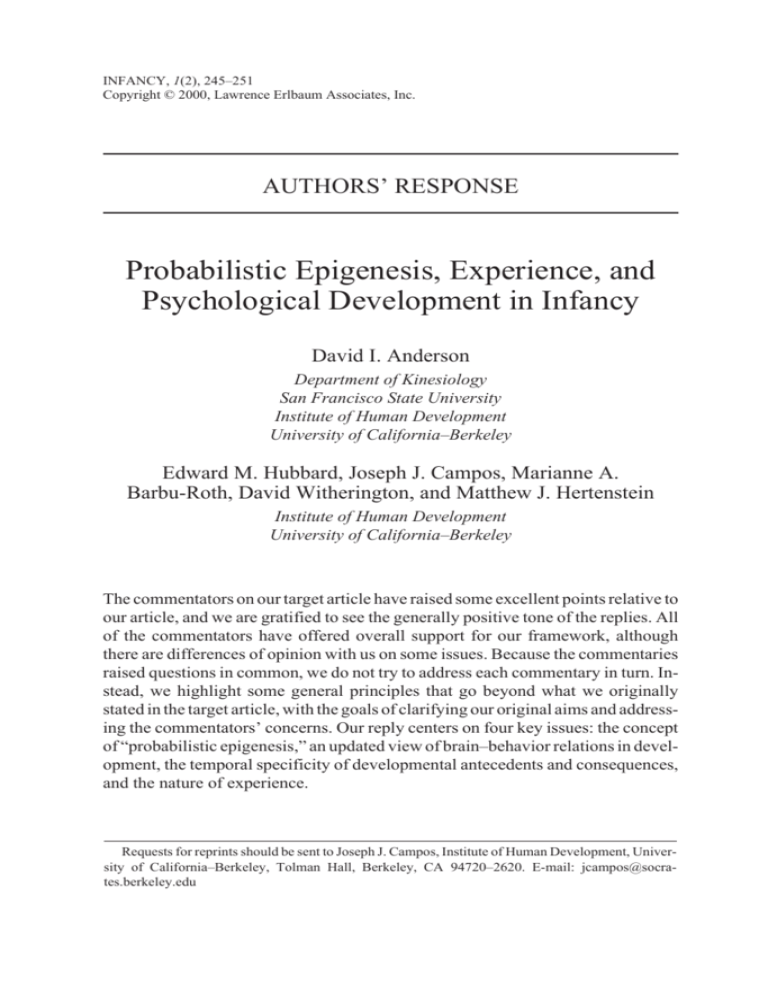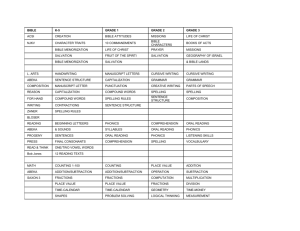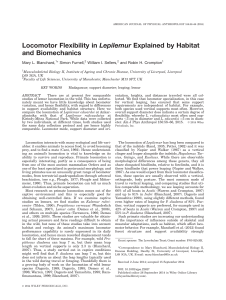Probabilistic Epigenesis, Experience, and Psychological
advertisement

INFANCY, 1(2), 245–251 Copyright © 2000, Lawrence Erlbaum Associates, Inc. AUTHORS’ RESPONSE Probabilistic Epigenesis, Experience, and Psychological Development in Infancy David I. Anderson Department of Kinesiology San Francisco State University Institute of Human Development University of California–Berkeley Edward M. Hubbard, Joseph J. Campos, Marianne A. Barbu-Roth, David Witherington, and Matthew J. Hertenstein Institute of Human Development University of California–Berkeley The commentators on our target article have raised some excellent points relative to our article, and we are gratified to see the generally positive tone of the replies. All of the commentators have offered overall support for our framework, although there are differences of opinion with us on some issues. Because the commentaries raised questions in common, we do not try to address each commentary in turn. Instead, we highlight some general principles that go beyond what we originally stated in the target article, with the goals of clarifying our original aims and addressing the commentators’ concerns. Our reply centers on four key issues: the concept of “probabilistic epigenesis,” an updated view of brain–behavior relations in development, the temporal specificity of developmental antecedents and consequences, and the nature of experience. Requests for reprints should be sent to Joseph J. Campos, Institute of Human Development, University of California–Berkeley, Tolman Hall, Berkeley, CA 94720–2620. E-mail: jcampos@socrates.berkeley.edu 246 ANDERSON ET AL. PROBABILISTIC EPIGENESIS: A DIFFERENT WAY OF STATING THE ROLE OF EXPERIENCE AND BIOLOGY IN DEVELOPMENT In their commentaries, both Bushnell and Marshall, Fox, and Henderson complained that we downplayed the biological contributions to developmental transitions. We take issue with them on two scores. First, biological factors were not the focus of our research, but the difference in focus does not mean neglect of biological factors. As we mentioned in the target article, “nothing that we say in this article should be construed as an argument against biological contributions to development. It is merely that our methods are more suited to discovering experiential contributions to development, rather than endogenous ones” (p. 154). Second, we believe that it is just as likely for experience and activity to influence brain development as the reverse. Nevertheless, this response gives us an opportunity to elaborate on our conceptual framework for understanding the role of biological and experiential contributions to development, and to do so, we draw on Gottlieb’s concept of probabilistic epigenesis (Gottlieb, 1991; Gottlieb, Wahlsten, & Lickliter, 1998). The concept of probabilistic epigenesis assumes a constant interplay between biology and experience. In this view, new behavior emerges as the outcome of transactions between genetic and environmental influences taking place at many hierarchically arranged levels—nucleus–cytoplasm, cell–cell, organism–environment, and organism–organism. Explicit in the probabilistic framework is the bidirectional, reciprocating nature of developmental change, whereby structural changes lead to changes in function, and functional changes result in structural ones in a cycle that continues throughout the life span. The interactions between biological and experiential factors represent a continuous, self-sustaining process that cannot be reduced to either the organism or the environment. Clearly, each component plays a role in all development, and without either, development does not take place. In the approach represented by the target article, we have held biology constant to constrain the degrees of freedom available when there are multiple components interacting at multiple levels of analysis. We systematically varied one component—an environmental factor—giving rise to a change in experience, to more systematically articulate the developmental process. This approach does not imply that we assign more formative influence to the environment over biology; rather, the quasi-experimental methods we use provide one means of examining experience, a means that ultimately relies on a constriction of natural complexity in interaction. Because we endorse converging research operations and designs, holding biology constant while studying variation in experience is simply one way of understanding development. It seems abundantly clear to us that the findings on the role of experience in psychological development stand on their own and have important epistemological EPIGENESIS, EXPERIENCE, AND DEVELOPMENT 247 and clinical implications even when biological considerations are held constant or are allowed to vary independent of experience. The separate contribution of biological factors to our findings is at this point unknown. Surely, it is not zero. However, it will remain for future work to understand how biological factors constrain, limit, or make possible the effects we found. The type of research we describe in the target article can just as readily be applied to the study of biological and contextual influences on development as they were to the study of experience. For instance, to study the effects of biology, a person can investigate twins to see whether monozygosity leads to the same or different results than dizygosity on the issue of the consequences of crawling experience. A person can also use direct or indirect assessments of the brain to see what brain processes might be prerequisites for the effects of locomotor experience. Similarly, a person can study the effects of locomotor experience in different contexts, such as cultures and ethnic groups that differ in their valuation of locomotion, to see whether such social factors influence the effects we have seen in the United States and China. It is possible that the results we reported in the target article are robust across such different contexts; it is also possible that some or all of the results are affected by the context in which locomotion takes place. Only further empirical work can answer such questions. A probabilistic epigenetic approach such as we take would lead to no surprise if results differ across such contexts and settings. However, pending the documentation of such biological and contextual influences, it would be a mistake to diminish the importance of locomotor experience on psychological development in settings such as those we investigated. BRAIN–BEHAVIOR RELATIONS IN HUMAN DEVELOPMENT Brain–behavior relations in development have often been described in maturationist terms. In other words, endogenous changes in the structure of the brain are often proposed as a cause of behavioral development. In probabilistic terms, however, brain maturation is as much a consequence of functional experience as functional experience is a consequence of brain maturation. Thus, we do not necessarily gain much by asking what part of the brain must mature for new behaviors to emerge. Undoubtedly, certain structural changes in the brain are necessary for specific skills to develop, yet structural maturation of the brain is but one of numerous anatomical, physiological, emotional, cognitive, and perceptual-motor prerequisites necessary for behavioral development. No prerequisite, by itself, is sufficient for behavioral development; however, each can act as a “rate limiter” by holding back the emergence of new behaviors. Ultimately, all prerequisites must be in place before the infant is ready to profit from specific experiences (McGraw, 1935); again, though, specific experiences contribute to 248 ANDERSON ET AL. the development and organization of the prerequisites from which behavior is assembled. Such a view compels us to think about how behavior changes the brain in addition to how the brain changes behavior (Thelen & Corbetta, 1994). Black, Isaacs, Anderson, Alcantara, and Greenough (1990) documented the former by showing that synaptogenesis accompanies motor learning in behaving animals. Taken together with other recent reports in neuroscience, these data suggest that the increase in EEG coherence discussed by Marshall et al. (this issue) can be the result of, and not a prerequisite for, locomotor experience. In the same vein, there is recent evidence indicating that the initial overabundance of synapses followed by selective pruning does not completely describe brain development (Quartz & Sejnowski, 1997, and commentaries therein). Instead, as Quartz and Sejnowski (1997) argued, experience leads not only to selective pruning of synapses, but also to increased synaptogenesis. This important aspect of contemporary neurophysiological thinking is not evident in the commentaries on our article. Conceptualizations of brain development must include directed growth in addition to selective pruning. So, contrary to Bushnell and Marshall et al.’s (this issue) assertions about our ignoring biology, our conceptualization of development is intimately biological; it is simply that the direction of effects our view implies can include the opposite of that of the commentators. It is also much more transactional. A heuristic implication of our research is to study experimentally how brain changes occur following the provision of locomotor experience. This study can potentially be conducted using the paradigm described by Anderson, Campos, Barbu-Roth, and Uchiyama (1999) in which infants are trained to control a powered mobility device. If there are changes in EEG coherence following such experimental training, it would be difficult to argue that such changes are due to biological preparedness stemming from experience-expectant neurons. Rather, it would argue for experience-dependent effects on brain function. REEMPHASIZING TEMPORAL FACTORS IN THE ROLE OF EXPERIENCE AND DEVELOPMENT The temporal specificity of developmental antecedents and consequences is relevant to our discussion in terms of the general processes underlying developmental change and the specific processes thought to be recruited by locomotor experience. Attempting to separate proximal and distal causes in development is much like trying to separate the roles of genes and the environment. The attempt merely highlights the multicausal and cascading nature of development. Development necessarily has a specific sequence such that at one point in time an antecedent might be a consequence of some other process and a consequence might be an antecedent to EPIGENESIS, EXPERIENCE, AND DEVELOPMENT 249 another process. As noted in the target article, one of the most significant aspects of self-produced locomotion (SPL) is that it is typically maintained once attained; in other words, and contrary to the Marshall et al. commentary (this issue), locomotor experience is continuously available once it begins and is not just an ephemeral passing phase. As such, it can continuously recruit the processes necessary to maintain the skills that it helped to bring about in the first place. This notion of maintenance is a hallmark of probabilistic epigenetic explanations of development (Gottlieb, 1991), although it is a notion that has received little attention in the literature on human development. The lack of attention is particularly surprising given Thelen’s comment (this issue) “it is people’s everyday, continuous postures and movements that form the support and maintenance for all our mental activities” (p. 224). It would be timely to put this hypothesis to the test and the test could be done by studying those individuals who have lost independent mobility to see how the loss affects the various psychological outcomes chronicled in the target article. DIFFERENT WAYS OF CONCEPTUALIZING EXPERIENCE The nature of experience is the final point of discussion on which we wish to elaborate. Consistent with the tenets of probabilistic epigenesis, we view experience as a relational process that captures transactions between the organism and the environment at multiple levels of analysis. Our research is focused at the behavioral level of analysis, and in that focus, experience is not synonymous with environment. Rather, our view of experience is more akin to functional activity—an inherently bidirectional process that involves both sensory and motoric processes. Such functional activity shapes and is shaped by other experiences (Wohlwill, 1973). We spoke directly to the bidirectional nature of experience in our discussion of the processes linking locomotor experience and spatial search: “Quite possibly, locomotor experience demands and sets up the contingencies associated with the development of more sophisticated means–ends behavior and the ability to tolerate delays in goal attainment” (p. 193). In his commentary, Rieser (this issue) cites vivid illustrations of the differences between environmental effects (watching the world from a bed) versus functional activity (engaging in a tennis match). Our view of experience is more the latter. When experience is viewed as a consequence of functional activity, as being dependent on goal-directed actions, it is possible to make a clear distinction between active and passive experience. Active experience is equivalent to functional activity, whereas passive experiences are those associated with the individual who is not engaged in functional or goal-directed activity. Passive locomotion (e.g., when carried by a parent, or when the limbs are manipulated to simulate locomotion) can recruit the processes necessary for the development of psychological 250 ANDERSON ET AL. skills, yet these activities are unlikely to recruit those processes as robustly as SPL. In contrast to passive locomotor experience, self-generated experiences are much more likely to recruit the processes underlying psychological development; indeed, we have preliminary evidence that time spent in an “exersaucer” (a walker without wheels that permits rocking and swiveling) facilitates the development of visual–postural coupling, although not to the same extent as walker or hands-and-knees crawling experience. SPL is not necessary for visual–postural coupling but a high degree of coupling is more likely with locomotor experience, much the same way that, as Rieser notes, visual experience is not necessary for the development of dynamic spatial orientation, yet the probability of a high level of learning is greater with visual experience. Finally, with reference to the active–passive distinction, it is relevant to note that in the motor-learning literature passive experiences (particularly those involving physical guidance and reliance on others for informational support) are thought to be poor substitutes for active experiences (Magill, 1998; Schmidt & Lee, 1999). On an anecdotal level, the “passenger effect” highlights the qualitative distinction between active and passive experiences on learning. It is well known that the driver of the vehicle is much more likely to be able to retraverse the route than the passenger, presumably because each is likely to process information differently during travel. Learning of the spatial layout incorporating the route has thus been mediated by the nature of the passenger’s and driver’s experiences. This example is especially relevant to our position because it also highlights the importance for spatial learning of the experiences associated with travel, rather than the mode of travel itself. SUMMARY AND CONCLUSION In the preceding pages, we have described one developmental transition, the acquisition of self-produced locomotor experience, and demonstrated that the experiences engendered by it are normally critical to the development of a number of psychological skills. This general developmental point is one that has received support from our commentators, even on those few occasions when they disagreed with aspects of our theoretical model. With the growing appreciation of the role of active, self-directed, motor experience on psychological development, future research should focus on the role of such experiences in the maintenance of psychological functions. In addition, research into alternative experiential pathways might more clearly define the exact nature of the interplay between organism and environment, and among the component processes that constitute a skill. These components should include, but not be limited to, brain processes. Ultimately, we need to specify how structure begets function, and function begets structures in the endless cycle that underlies human development. EPIGENESIS, EXPERIENCE, AND DEVELOPMENT 251 REFERENCES Anderson, D. I., Campos, J. J., Barbu-Roth, M. A., Uchiyama, I. (1999, June). Motor behavior and psychological function. Paper presented at the North American Society for the Psychology of Sport and Physical Activity, Clearwater Beach, FL. Black, J. E., Isaacs, K. R., Anderson, B. J., Alcantara, A. A., & Greenough, W. T. (1990). Learning causes synaptogenesis, whereas motor activity causes angiogenesis, in cerebellar cortex of adult rats. Proceedings of the National Academy of Sciences of the United States of America, 87, 5568–5572. Gottlieb, G. (1991). Experiential canalization of behavioral development: Theory. Developmental Psychology, 27, 4–13. Gottlieb, G., Wahlsten, D., & Lickliter, R. (1998). The significance of biology for human development: A developmental psychobiological systems view. In R. M. Lerner (Vol. Ed.) & W. Damon (Series Ed.), Handbook of child psychology: Vol. 1. Theoretical models of human development (pp. 233–274). New York: Wiley. Magill, R. A. (1998). Motor learning: concepts and applications (5th ed.). New York: Brown. McGraw, M. B. (1935). Growth: A study of Johnny and Jimmy. New York: Appleton-Century-Crofts. Quartz, S. R., & Sejnowski, T. J. (1997). The neural basis of cognitive development: A constructivist manifesto. Behavioral and Brain Sciences,20, 537–596. Schmidt, R. A., & Lee, T. D. (1999). Motor control and learning: A behavioral emphasis (3rd ed.). Champaign, IL: Human Kinetics. Thelen, E., & Corbetta, D. (1994). Exploration and selection in the early acquisition of skill. International Review of Neurobiology, 37, 75–102. Wohlwill, J. F. (1973). The concept of experience: S or R? Human Development, 16, 90–107.









